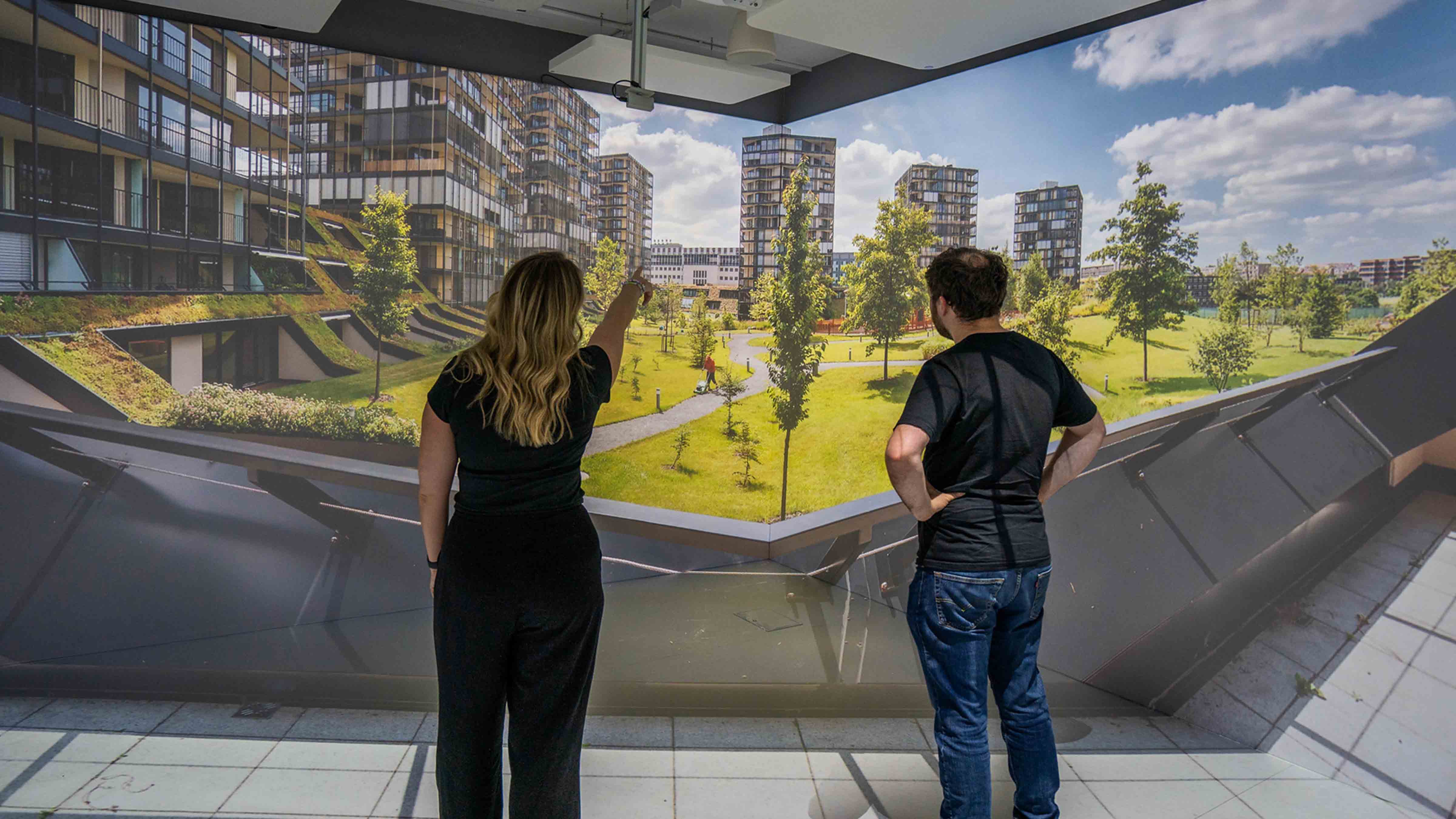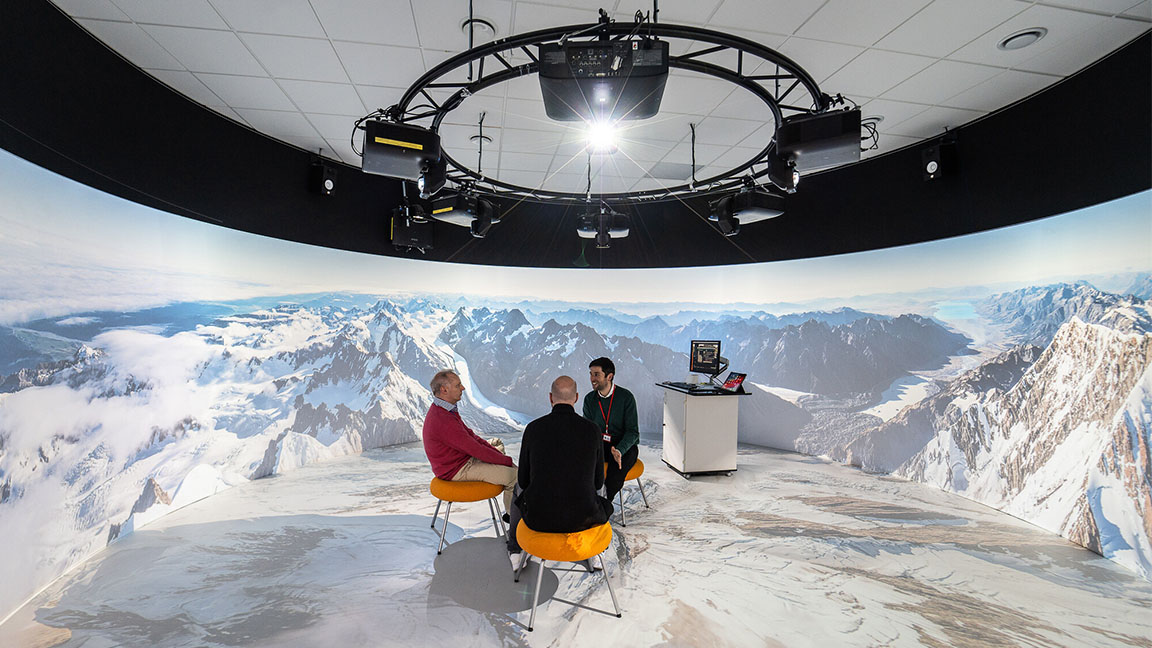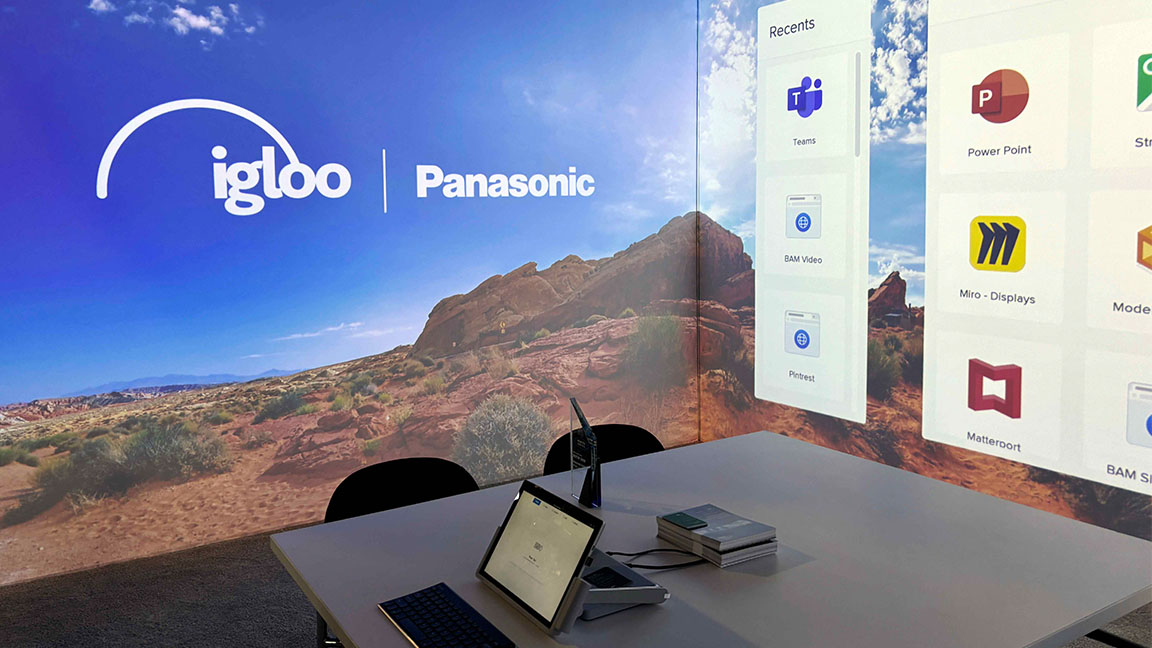At InfoComm last year in Las Vegas, the Panasonic Connect booth featured an immersive meeting room demo that demonstrated the benefits of an enhanced collaboration experience. We're talking a conference table surrounded by wall-to-wall, floor-to-ceiling projected content showing everything from scenic backgrounds to flowcharts and apps. It was the result of a partnership with U.K.-based immersive spaces developer Igloo Vision, which also partnered with Christie and Fuji to showcase immersive spaces in their booths at the show.
[Viewpoint: If You Build It, Will They Come?]
So, are these the meeting spaces of the future? No—according to Igloo Vision, these innovative areas are already the meeting spaces of today.
Streamlining Cooperation
Immersive collaboration spaces allow meeting participants to view and manipulate data in new ways, explained Kerry Head, CEO at Igloo Vision. She said the AECO (architecture, engineering, construction, and operations) disciplines are using the technology to streamline the collaborative process, most notably by leveraging the ability to view digital twins of construction sites and engineering projects—and make design modifications on the fly, in real time, while meeting.

These collaborative spaces can offer immersive experiences to both onsite meeting contributors and remote participants. “This is another really powerful tool, as you can see scale far beyond what a 2D render can provide, while also not compromising in-person meetings, which is a big advantage over using VR headsets,” she added. “We’ve seen this used by clients to conduct things like virtual site visits, completely eliminating the need to travel and the associated cost, time, and carbon footprint that comes with that."
Immersive collaboration space deployment involving Igloo Vision's technology consists of three primary components. First, there is the Igloo Core Engine (ICE), a software platform that Head likened to an operating system. Next is the hardware, which must be chosen with care based on the specific use case requirements for pixel density, audio, and even the application of sensors and head-tracking capabilities.
Igloo Vision has partnered with several OEMs that produce systems suitable for these environments; it also offers the Igloo Media Player (IMP), a single solution for Igloo Vision spaces. “Previously, to run a space like this you would need a combination of bulky technologies, but with an IMP it’s all run from one sleek box,” she said. (The IMP is available in Pro and Lite versions, based on customer needs.)
Content formatting is the third core component of an immersive collaboration space rollout, an important consideration if meeting participants are to view materials as they should. “This can often be trickier than you might think, as many solutions suffer from distortion if they’re not programmed properly—and that programming to make sure it’s correct can be a very complex job,” Head explained. Igloo Vision’s True Perspective feature is designed to facilitate this process by enabling users to perform content formatting with the click of a button, she added.
Location, Location, Location

Igloo Vision executes projects directly for end clients, but also works with AV designers and integrators. Immersive collaboration spaces from Igloo Vision can be custom, prefabricated, or installed into an existing facility that has been retrofitted for this purpose. Head said that prefabricated spaces—commonly in the form of a freestanding cube or cylinder that is mounted into an existing room—are the most popular among her company's customers, but that clients can achieve immersive collaboration in spaces of all sizes and shapes.
In fact, she recalled a project for a well-known real estate firm where an old broom closet was converted into an immersive collaboration space. "On the opposite end of the spectrum, we’ve installed bespoke designs that are much, much larger,” Head noted. “It’s all down to the client’s preference, what they want to achieve, and what they have available, [and] we work with whatever that might be.”
One challenge in delivering a true immersive experience is when the space features glass walls or windows. Head argued the problem is easily resolved: “We’ve had clients in the past that required dual-purpose rooms, so it was both an immersive space and a conventional meeting room,” she said. “To achieve this, we install blinds over the windows that are color-graded in the specific tone we know is most effective for projection, and these can be extended or retracted based on the needs of the room at the time.”

That said, the best immersive collaboration experiences are those that are as distraction-free as possible, according to Joe Whitesides, CTS-D, director of experience technology (XTG) at AVI-SPL. “You need to pick places where there’s less stimuli—fewer windows or no windows,” he said.
For a space to be immersive, all aspects of the environment should be controlled, including acoustics. “You don’t want to be able to hear anything outside [of the space] that would distract you from the message [that’s being delivered in the space],” Whitesides said.
When immersive collaboration spaces incorporate videoconferencing capabilities, Whitesides warned they run the risk of compromised camera performance. “You’re not going to get great exposure in a dark environment,” he explained, “so [during a videoconference] you’re not going to look your best.”
Let Me Show You Something

Display technology is a primary element of an immersive collaboration environment, and whether to specify dvLED or projection depends, once again, on the use case. According to Whitesides, the problem with dvLED is the heat, which can render a space uncomfortable for long collaboration sessions. At the same time, ambient light issues could complicate the delivery of an optimum experience that’s projector driven. “But there’s a cool factor to that, where you’re in a kind of theatrical mode,” Whitesides conceded. “People change their behaviors in these theatrical modes.”
The need for interactivity is another factor to consider when designing these environments. When integrated with displays, sensor technology can transform entire walls or conference tables into giant interactive tablets. In these spaces, Whitesides suggested the interactive walls need to be flat. When the space features curved displays, a table with interactive capabilities may be a better solution.
One of the challenges associated with selling immersive collaboration spaces is that it’s difficult to describe to clients the possibilities the technology has to offer. What’s more effective is when customers can experience these environments themselves. This is why tech developers and manufacturers are focusing on building showrooms that clients may visit to gain insight into the options that exist.

“Having a place where you can take customers—either physically or virtually—to experience the room is really important because people don’t realize what can be done,” said Petro Shimonishi, director of new business development at Panasonic Connect.
For these deployments to be successful, Shimonishi underlined the need for good communication between all project stakeholders. “Communicate with your industrial designer or interior designer,” she advised, noting that a siloed approach to project execution will produce unnecessary obstacles. “Having good communication amongst the different disciplines that are doing the construction is extremely important.”
[Viewpoint: Office Buzz or Buzzkill]
Shimonishi also encouraged AV designers and integrators to lean on their manufacturer partners for guidance and support when it comes to equipment selection, placement, and configuration. “You don’t need to do this on your own,” she said. “We’re here to help as people start easing into fully immersive spaces.”
